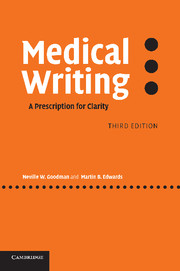Book contents
- Frontmatter
- Contents
- Preface to the first edition
- Preface to the third edition
- Acknowledgements
- PART I PROBLEM: THE ILLNESS
- PART II SOLUTION: SYMPTOMATIC RELIEF
- 3 Guidelines to clearer writing
- 4 Is there a better word?
- 5 Superfluous words
- 6 Imprecise words and phrases
- 7 Superfluous phrases
- 8 Trouble with short words
- 9 Use of the passive voice
- 10 Consistency: number and tenses
- 11 Circumlocution, metaphor and cliché
- 12 Word order and pronouns
- 13 Punctuation
- 14 Constructing sentences
- 15 Drawing clear graphs
- PART III PRACTICE: RECUPERATION
- Appendix: examples to rewrite
- References and further reading
- Index
11 - Circumlocution, metaphor and cliché
Published online by Cambridge University Press: 23 November 2009
- Frontmatter
- Contents
- Preface to the first edition
- Preface to the third edition
- Acknowledgements
- PART I PROBLEM: THE ILLNESS
- PART II SOLUTION: SYMPTOMATIC RELIEF
- 3 Guidelines to clearer writing
- 4 Is there a better word?
- 5 Superfluous words
- 6 Imprecise words and phrases
- 7 Superfluous phrases
- 8 Trouble with short words
- 9 Use of the passive voice
- 10 Consistency: number and tenses
- 11 Circumlocution, metaphor and cliché
- 12 Word order and pronouns
- 13 Punctuation
- 14 Constructing sentences
- 15 Drawing clear graphs
- PART III PRACTICE: RECUPERATION
- Appendix: examples to rewrite
- References and further reading
- Index
Summary
Circumlocution
Do not use lengthy phrases and definitions instead of single words. It is worth asking someone to check over your writing; people unfamiliar with the subject matter of a paper are more likely to detect these circumlocutions. Take this example.
Oral visual screening … has the potential of preventing at least 37000 oral cancer deaths worldwide.
The COD definition of can is ‘potentially capable of’: can prevent is better here, or, if a little circumspection is needed, could prevent. ‘Oral visual screening’ is looking in the mouth.
With some circumlocutions, the fault is not that a particular word has been expanded to its definition, but that the message can be expressed more succinctly. The ability to do this is especially useful when there is a word limit – for instance when submitting abstracts.
… the range of paediatric patients suitable for ventilation …
… following open heart surgery in paediatric patients.
Paediatric patients are children. Write neonates, infants or older children, if these are what you are referring to; otherwise children is the inclusive term.
… to determine the magnitude of the change in plasma potassium …
To determine the magnitude is to quantify or to measure.
This comprises of increased blood pressure and pulse amplitude in the upper extremity and decreased blood pressure and pulse amplitude in the legs.
This should be blood pressure in the arm; the upper extremity can include the shoulder. There is also unnecessary repetition of blood pressure and pulse amplitude and an incorrect usage – COMPRISES (of).
- Type
- Chapter
- Information
- Medical WritingA Prescription for Clarity, pp. 152 - 160Publisher: Cambridge University PressPrint publication year: 2006



